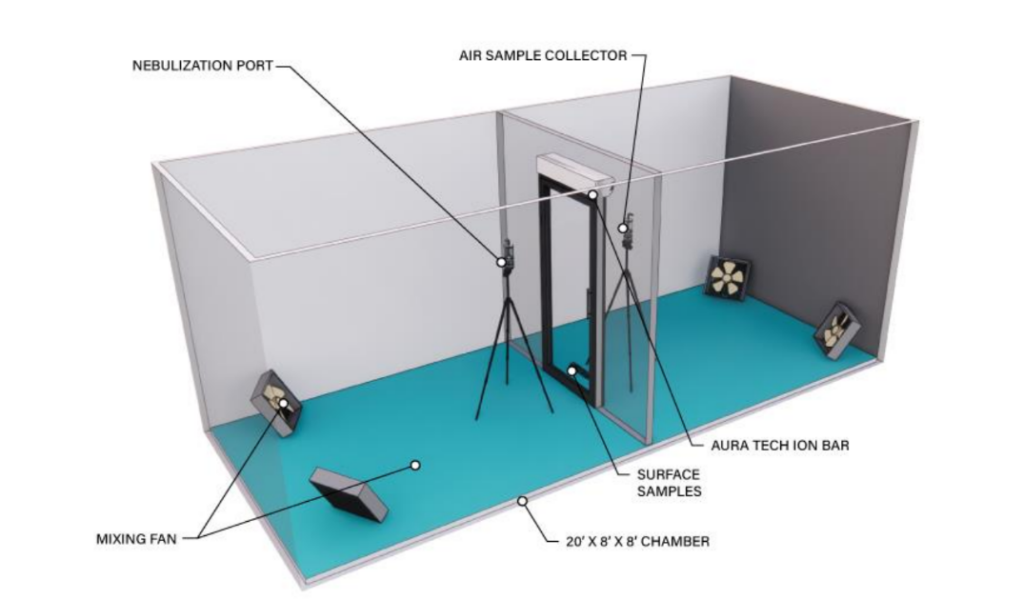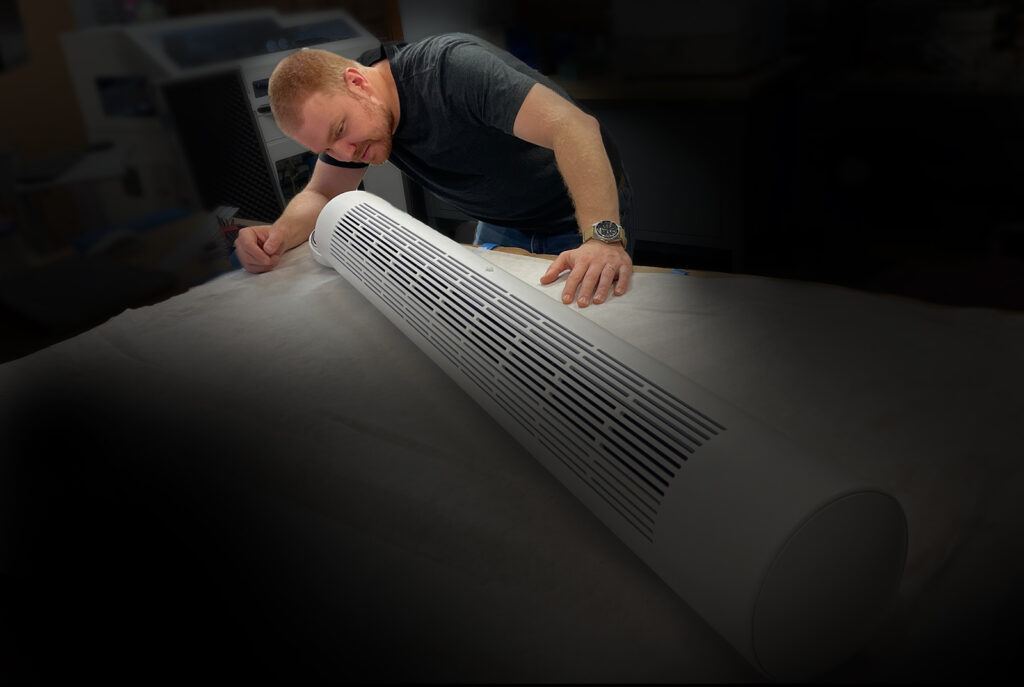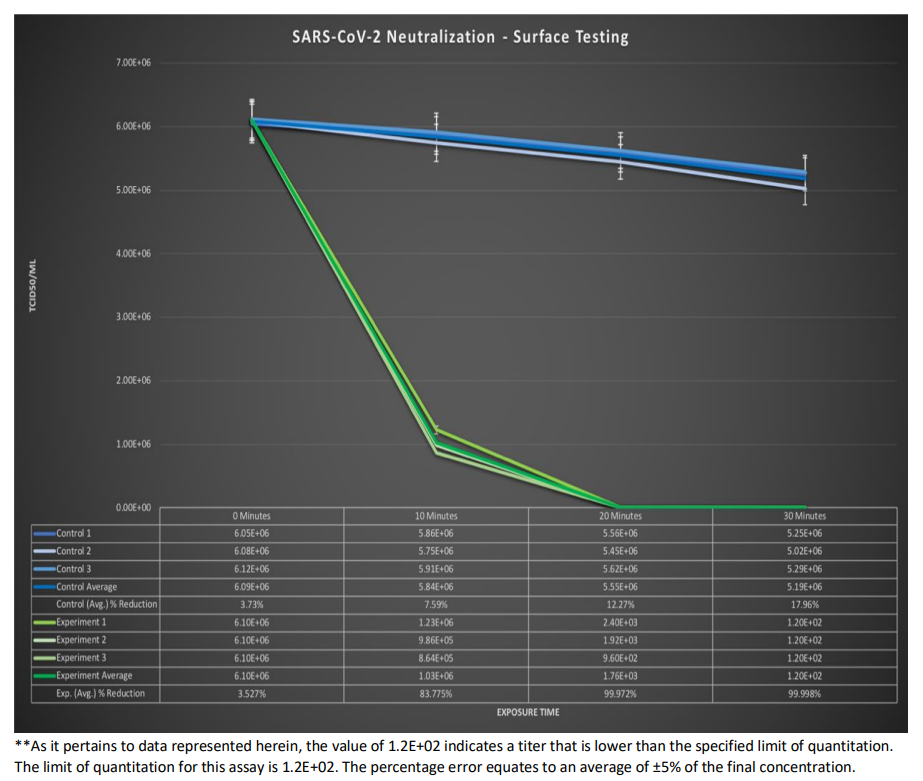Amidst the rise of Covid-19, we were urged to mask up, keep our distance, and wash our hands frequently. But as the pandemic unfolded, research showed that the virus could travel through the air well beyond six feet and linger in the air for several hours. In a revealing episode of CBS’s 60 Minutes, air quality scientists highlighted that protecting our indoor air quality should have been just as important – if not more important – than other preventative measures to slow the spread.
In a market flooded with products lacking adequate testing, the AURA team was determined to put in the work needed to guarantee a product that performed as advertised and one that prioritized safety. The AURA Ion Bar was meticulously designed with safety in mind. However, what good is safety if it doesn’t deliver results? To ensure its effectiveness, the AURA team conducted thorough testing of the Ion Bar, including testing against aerosolized SARS-CoV-2 (Covid-19), and the results speak volumes.
The Testing
“It should all work in principle, but will it work in practice?” This is the question that Alex Blate, PhD, Chief Innovator at AURA and others were asking themselves ahead of lab testing the Ion Bar. They had done the work on paper, but now was the real test.
The team began by finding an accredited lab that was able to perform aerosol testing with real SARS-CoV-2 virus samples. Innovative Bioanalysis, a lab based in Costa Mesa, California, was the one to take on the job. One of the studies conducted, titled AURA TECHNOLOGIES ION BAR EFFICACY IN SARS-COV-2 DEACTIVATION, took place over the course of 6 weeks in 2021. Conducted in a controlled laboratory environment, the study included testing with aerosolized SARS-CoV-2 to assess the effectiveness of the AURA Tech Ion Bar against the known pathogen.
The 20 ft x 8 ft x 8 ft testing chamber was maintained at a temperature of 77.2 °F ± 2 °F with a relative humidity of 49%. The chamber had a displacement volume of 1,280 ft3 (36,246 L) of air and remained sealed during testing. Most testing rooms for other indoor air quality products are not this size, giving skewed and unreliable test results. The AURA team was committed to thoroughly testing Ion Bar in a larger room, ensuring more accurate test results of how the Ion Bar would work in a real-life setting.
Dr. Blate recalled that a new test protocol had to be created for Ion Bar. “There’s no device like Ion Bar out there. It’s the first of its kind, so they didn’t have an ‘off-the-shelf’ protocol that they could use.” Ion Bar is the first of its kind to block contaminants from your space before they enter. This required a unique testing chamber. Inside the chamber, a simulated wall with a doorway frame was constructed to split the chamber into two 10 ft x 8 ft x 8 ft sections with the Ion Bar mounted above the doorway, approximately 7 ft above the floor on the “clean” side.
 We needed to release the Covid virus into the room and onto surfaces similarly to the way the virus would naturally spread. To do this, a viral media containing 6.32 × 106 TCID50/mL* of SARS-CoV-2 was inoculated onto glass slides as control and challenge samples for surface testing, using fetal bovine serum (FBS) as a base.
We needed to release the Covid virus into the room and onto surfaces similarly to the way the virus would naturally spread. To do this, a viral media containing 6.32 × 106 TCID50/mL* of SARS-CoV-2 was inoculated onto glass slides as control and challenge samples for surface testing, using fetal bovine serum (FBS) as a base.
For the aerosol testing, the same concentration of the virus was used, but instead of using glass slides, the virus was nebulized and sprayed into the room. This simulated its natural airborne transmission in situations where an infected individual continually coughed or sneezed.
*TCID50/mL, or the concentration of virus needed to infect 50% of cells exposed to the virus, is a standard way to quantify how much infectious virus is being delivered. This measure is more accurate than the concentration of virus itself (which may be substantially higher), as TCID50/mL only counts infectious or ‘viable’ viral particles – the ones that can actually do us harm. The protein-rich FBS-based liquid viral delivery medium creates a favorable environment for the virus, preserving its viability in the air and on surfaces, much like the virus-laden mucous delivered by a sneeze to the air or a sniffle to a surface.
For surface testing, the samples were placed on the clean side of the floor, approximately 2 ft from the doorway, and exposed for 10, 20, and 30 minutes. For the aerosol test, the spraying of the aerosol testing took place 5 ft above the floor, 1.5 ft away from the doorway, and pointed towards the door while air samples were collected at the same distance from the clean side for 2 minutes. By doing these two tests, we were able to simulate how the Covid virus would interact in the air and on surfaces with the Ion Bar product running.
The Results
Surface Testing
Ion Bar provides two layers of defense: a powerful air curtain and the flow of negative air ions (NAIs). The goal of the surface testing was to showcase the NAIs in action, specifically, how efficiently they inactivated the SARS-CoV-2 virus. The test results below show that the Ion Bar produces enough NAIs to effectively inactivate the virus on surfaces up to seven feet away from the device.
Control samples – samples not exposed to negative ions or airflow from the Ion Bar but otherwise treated identically – were placed to show the natural viability loss without Ion Bar running. Against SARS-CoV-2, the Ion Bar lowered a starting concentration of 6.32 × 106 TCID50/mL to an average of 1.03 × 106 TCID50/mL (83.775%) after 10 minutes. The concentration of active SARS-CoV-2 was further reduced to 1.76 × 103 TCID50/mL (99.972%) after 20 minutes, and to below the assay quantitation limit after 30 minutes (>99.998%).
To put it simply: after 10 minutes, about 1/6th of the virus remained active. After 20 minutes, about 1/3,500th was still active. By the 30-minute mark, there was no trace of the active virus (less than 1/50,000th of its initial concentration).
Aerosol Testing
To release Covid into the chamber similarly to how the virus is exhaled by an infected person, Innovative Bioanalysis aerosolized the virus using a nebulizer, generating particles ranging from 0.1 to 5 micron and with an average size of 0.8 micron. The aerosol test was conducted to determine how much aerosolized SARS-CoV-2 could pass through an open doorway protected by the Ion Bar over 2 minutes of device operation.
From the inside of the air barrier, the concentration of active SARS-CoV-2 collected at 2 minutes was approximately 1.16 × 103 TCID50/mL. This means that about 0.018% of nebulized SARS-CoV-2 passed through the barrier over 2 minutes, compared to the 71.07% of nebulized and viable SARS-CoV-2 virus that passed through without the Ion Bar device. The Ion Bar was able to block 99.982% of the virus aerosols from entering the room.
Dr. Blate commented that the AURA Ion Bar is a “fundamental paradigm shift in thinking about air quality: real-time prevention versus long-term treatment. It reveals a fundamental gap in almost all air quality systems – a gap that Ion Bar uniquely and comprehensively closes.” Instead of cleaning the air over time as an air purifier would, Ion Bar prevents your air from becoming contaminated in the first place.
 In summary, the results of the surface testing were nothing short of impressive. After just 30 minutes of operation, the concentration of SARS-CoV-2 was dramatically reduced to below quantification limits (>4.57 log* reduction). When it came to aerosol testing, the germicidal barrier proved to work as a forcefield, blocking an outstanding average of 99.98% (3.69 log) of active SARS-CoV-2 from entering during device operation. These noteworthy findings highlight the effectiveness and potential of this innovation in our ongoing battle against the virus.
In summary, the results of the surface testing were nothing short of impressive. After just 30 minutes of operation, the concentration of SARS-CoV-2 was dramatically reduced to below quantification limits (>4.57 log* reduction). When it came to aerosol testing, the germicidal barrier proved to work as a forcefield, blocking an outstanding average of 99.98% (3.69 log) of active SARS-CoV-2 from entering during device operation. These noteworthy findings highlight the effectiveness and potential of this innovation in our ongoing battle against the virus.
*Infectious disease scientists often use “log” (logarithmic) reduction to measure the efficacy of germicidal products. One log is a factor of ten. Two logs is a factor of one hundred. Three logs is a factor of one thousand. A typically-stated efficacy of something like hand sanitizer or alcohol wipes is 99% — a 2 log reduction. An N95 mask is designed to block a minimum of 95% of certain contaminants, or about a 1.3 log reduction. Ion Bar blocks 99.98% of contaminants, or about a 3.69 log reduction – about 245 times better than an N95 mask.
Seeing The Results
When creating a new piece of technology like the Ion Bar, it’s hard to not be skeptical. Garrett Goss, Associate Director of Engineering at AURA, recalls how the team felt going into their first round of testing, “As a team, we were somewhere between highly-skeptical and cautiously optimistic that it would work anywhere near as well it did,” noting, “it’s one thing to read the literature and see some evidence that this might work, but it’s another entirely to see results like this in real-world testing.”
When the test results came back, the AURA team was ecstatic. Dr. Blate specifically remembers seeing the 99.98% number and thinking, “Wow, okay, we did something really good here.”
“There’s something I think a lot of people get wrong about science.” Goss said regarding the Ion Bar testing. He continues, “They think it’s about designing experiments to prove that you’re right, when really, if you’re doing that, you’re just a bad scientist. Your job is to try everything you possibly can do to prove yourself wrong, and if you are unable to do so, then you might have something.”

After receiving the test results, the AURA team knew they had something. Something that worked. Something that had been shown to reduce the transfer of Covid. Something that could change the indoor air quality space as we know it.
How and Why it Works
The “why” can be answered simply- our team dedicated countless hours of their time perfecting this product, and the test results reflect that.
The “how” is a bit more intricate.
Ion Bar is designed to create a protective sheet of air, enriched with a high concentration of negative air ions (NAIs) to create an invisible barrier. This barrier blocks contaminants before they enter your space, but also removes contaminants from your breathing zone. The flow separates air masses and pushes contaminants out of your breathing zone, while the NAIs are simultaneously inactivating the contaminants and causing them to form clumps and fall out of the air. This is why Ion Bar is like no other device on the market.
Dr. Blate says, explaining further, “One way to think of it is as an air curtain where you’ve dialed back the air velocity, and therefore dialed back the noise and the discomfort you get of walking through a ‘hurricane.'” He continues, “A normal air curtain doesn’t have any disinfecting properties, so when something makes it past the curtain, there’s nothing to stop it from there – that is what the ions are for. They make up for the lower air velocity and they provide a second layer of defense. Anything that does make it past the barrier is likely to get inactivated or precipitated out of suspension by the ions before they’re able to enter your space.”
To learn more about how Ion Bar works, click here.
At the end of the day, the Ion Bar is more than just a symbol of innovative thinking and scientific testing. It’s a beacon of hope in the ongoing battle against airborne diseases.
AURA Co- CEO, Anna Bennett said about Ion Bar, “We aimed to fight Covid-19 by creating something of value. After 3 years of dedicated development and successful lab studies, the astonishing results surpassed all expectations. Now, we’re ready to share this technology and continue the fight against indoor air pathogens.”
Ion Bar’s incredible ability to significantly reduce active SARS-CoV-2 on surfaces and in the air demonstrates the potential for this technology to revolutionize the way we approach indoor air quality. But beyond that, what truly defines the value of the Ion Bar is its potential to restore a sense of safety and normalcy to our shared spaces.
Resources:
- Yee, Dana, et al. “AURA Technologies Ion Bar efficacy in SARS-COV-2 deactivation”. Innovative Bioanalysis, Inc. February 2022. AURATechnologies-IonBar-COVID-TestResults2022.pdf (auraionbar.com)
- Indoor air systems crucial to curbing spread of viruses, aerosol researchers say – CBS News
- AURA Ion Bar | AURA Ion Bar™

